The Polar Express: 8 Cool Behind-The-Scenes-Facts About The Tom Hanks Movie
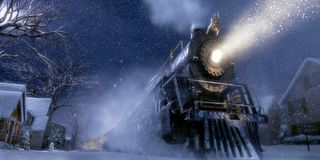
Christmas is here, which means it's time to take another ride on The Polar Express. Now part of the annual Christmas movie rotation, looking behind the scenes at the adaptation of Chris Van Allsburg's classic children’s book shows the film’s impact goes beyond providing some holiday cheer.
The Polar Express tells the story of a young boy who is questioning whether or not he believes in Santa Claus. Then, on Christmas Eve, a magical train - the Polar Express - appears outside his home and whisks him away to the North Pole to restore his belief in Santa and all that he embodies.
The 2004 film was made by Robert Zemeckis and starred Tom Hanks - the pair’s third collaboration after Forrest Gump and Cast Away. Hanks, as has been well documented, played six different roles through the magic technology of performance capture, including the young boy, the conductor and Santa himself. (If you didn’t know that, well hey, bonus fact for you.)
So what went into making The Polar Express? Let’s take a look at these fun behind-the-scenes facts.
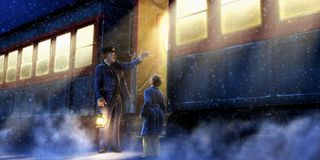
Tom Hanks Was The First To Hop On The Polar Express
Chris Van Allsburg published The Polar Express in 1985. The book was praised for its simple but heart-warming story and its gorgeous illustrations. It quickly became a staple for any household with young children at Christmas time. That included the Hanks household.
Hanks, in an interview with IGN in the lead-up to The Polar Express’ initial release, said that he had been reading the story to his kids since it came out. So, in 1999 he acquired the rights to make a film adaptation. In describing what drew him to bringing the story to the big screen, Hanks said:
There’s something very stunning, quite frankly, about Chris Van Allsburg’s paintings. They’re not drawings. They’re impressionistic versions of this child’s house and what it was like to be on a train and all the aspects of the adventure that they go on. It was always a very tactile feeling that I got from reading the book as well as a very elegant, simple, but complicated, sophisticated story about what Christmas means to each and every one of us.
There was one condition that Allsburg stipulated when giving Hanks the rights - he did not want the film to be animated. This would ultimately lead to the decision on using performance capture, but we’ll talk more about that in a bit.
CINEMABLEND NEWSLETTER
Your Daily Blend of Entertainment News
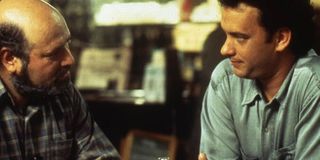
Rob Reiner, Not Zemeckis, Was Originally Attached To Direct
Despite Hanks’ history with Robert Zemeckis, he was not the first director attached to The Polar Express. Instead, the first man expected to be behind the camera was This Is Spinal Tap and The Princess Bride director Rob Reiner. Reiner, while never directing Hanks before, starred opposite him in Sleepless in Seattle.
Hanks’ Playtone production company partnered with Reiner’s Castle Rock when the movie was in development as a directing vehicle for Reiner, with Hanks at that point only planning to play the conductor.
However, as often happens as movies develop, things changed. Reiner bowed out of the director’s chair. While he has no official credit with the film, Castle Rock still served as one of its production companies.

Performance Capture Wasn’t Always The Plan
As mentioned above, Van Allsburg did not want The Polar Express to be an animated film. Robert Zemeckis, after he came onboard as director, agreed, thinking that the book’s classic look would not work with traditional animation techniques. However, he also didn’t believe it was possible to film The Polar Express the way it needed to be done as a live-action movie.
However, the decision to go with performance capture technology, which was still in its infancy at this point, was no certainty. In fact, Zemeckis was toying with a few ideas to shoot the film, including using green-screens to place live-action actors in digital environments like George Lucas did with the Star Wars prequel trilogy. Ken Ralston, who had worked with Zemeckis on Who Framed Roger Rabbit and Forrest Gump, was actually the one that pushed for performance capture.
But it still had to be tested out. David Schaub, The Polar Express animation supervisor, journaled his work on the film for Animation World Network, where he detailed that it took his team three months to experiment and produce the eight shots of performance capture that would be presented to Warner Bros. as a proof of concept.
Even though they were learning on the job on how to make all the body movements right, performance capture won out.

The Polar Express Was Shot Entirely In A 10x10-Foot Area
Once the decision was made to use performance capture, the whole production changed. One of the most notable ways was that a traditional set was no longer needed. Instead, filming Hanks and the rest of the cast would take place entirely in a 10x10-foot area on a soundstage, which Hanks actually found freeing.
Once again in his interview with IGN, Hanks said:
I found … that it is actually a return to a type of acting that acting in films does not allow you to do. It was exactly like rehearsing a play in the round. You don't have to worry about lights, angles, rails, cameras, over the shoulders coverage. We essentially did a great series of 10 or 15 minute plays in which we did it real, we did it all in real time, and when we were done Bob had everything that he needed to. So, as far as being an actor goes, it was a blast.
Zemeckis would use that footage from the day, and thanks to having multiple cameras on set capturing the action in 360-degrees, the technology of performance capture could then create almost any type of shot Zemeckis wanted.
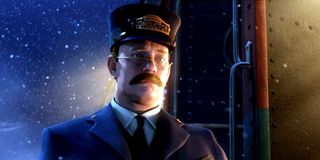
The Infamous "Dead Eye" Problem
Of course, performance technology didn’t have all of its kinks out yet. One of the major concerns from the early days of the technology, including for The Polar Express, is that the character’s were often described as dead-eyed.
A piece in Wired explaining the performance capture technology in 2004 detailed that Hanks had about 152 markers on his face that would take about 50 minutes to apply to capture his performance (still better than the make-up Jim Carrey had to go through for his Christmas movie How the Grinch Stole Christmas). However, even with all of those markers, there was still a problem capturing the movements of the eyes.
David Schaub, again in his AWN journal, said that the problem was that the markers would become occluded under the fat pad between the lids and the brow, essentially rendering them unusable. So, instead of performance capture, they went with animated eyes and eyebrows.

Josh Hutcherson Served As Tom Hanks’ Stand-In
With Tom Hanks taking on so many roles in The Polar Express, including some that appeared on screen together, they had to find a young actor to serve as his stand-in for Hero Boy in certain scenes. That job would go to Josh Hutcherson, of The Hunger Games franchise.
Hutcherson is one of three people who are credited with bringing Hero Boy to life. The other two are Hanks and Daryl Sabara, who provided the voice for the character.
Thankfully for us, Hutcherson’s time working on The Polar Express wasn’t uneventful. In an interview with James Corden, Hutcherson revealed that he had a slightly embarrassing moment when acting opposite Hanks.
We're shooting this scene where he's playing the hobo and he's on top of the train, skiing down, and I'm nestled under him, and we're like, 'Woah, this is crazy.' I farted. I farted in the scene, it happened, I did it and instead of playing it cool, Tom Hanks is like, 'Woah, woah, oh my God, this kid, what the heck.' My first big movie and I just farted in his face. It was a rite of passage and looking back on it, it was very funny, but at that moment, I thought my face was gonna just start sweating blood.

The Polar Express Has A Great Back To The Future Easter Egg
The Polar Express is a magical train, picking up kids from all over the world on Christmas Eve, whisking them away to the North Pole and returning them safely to their beds before Christmas morning. How does it do all this? A previous Robert Zemeckis film may have the answer.
Zemeckis directed the Back to the Future trilogy, and some eagle-eyed viewers of The Polar Express noticed that the flux capacitor is present in the engineer’s booth. Another fun tidbit connecting the two films, though it is never specifically mentioned, the film is set in 1955, the same year that Marty McFly traveled to in Back to the Future.
Maybe Doc Brown donated his time traveling train to Santa when he was all done with it.
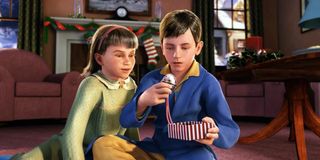
Guinness World Records Recognizes The Polar Express As First Film to Entirely Use Performance Capture
Performance capture technology was not invented for The Polar Express. Films like The Matrix and The Lord of the Rings had used it in some form or capacity previously. However, as certified by Guinness World Records, The Polar Express is the first film to be made entirely with performance capture technology.
Also, it is still recognized as the longest performance capture film at 1 hour and 33 minutes. Zemeckis’ would return to the technology for Beowulf and The Christmas Carol - as well as portions of Welcome to Marwen - however Guinness says that its records are up to date, so it is likely that some other technology was used to help bring those films to life and keeps The Polar Express in the record books.
There’s no better time of year to rewatch The Polar Express, and when you do you can now share some of these details to impress your family and friends. Happy holidays all!
D.C.-based cinephile. Will dabble in just about any movie genre, but passionate about discovering classic films/film history and tracking the Oscar race.
Most Popular






